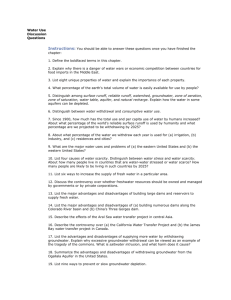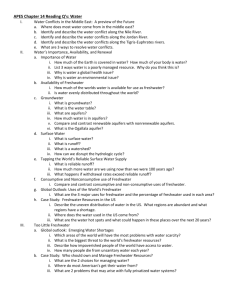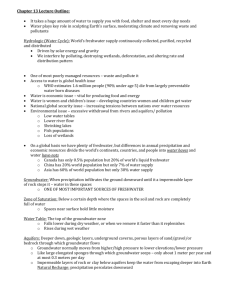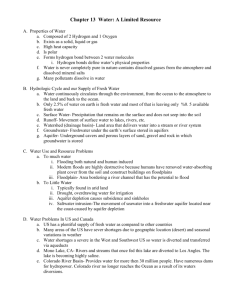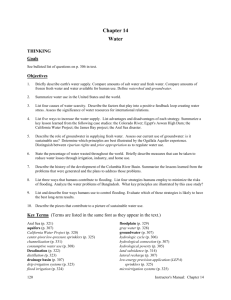Goals - APES Room
advertisement
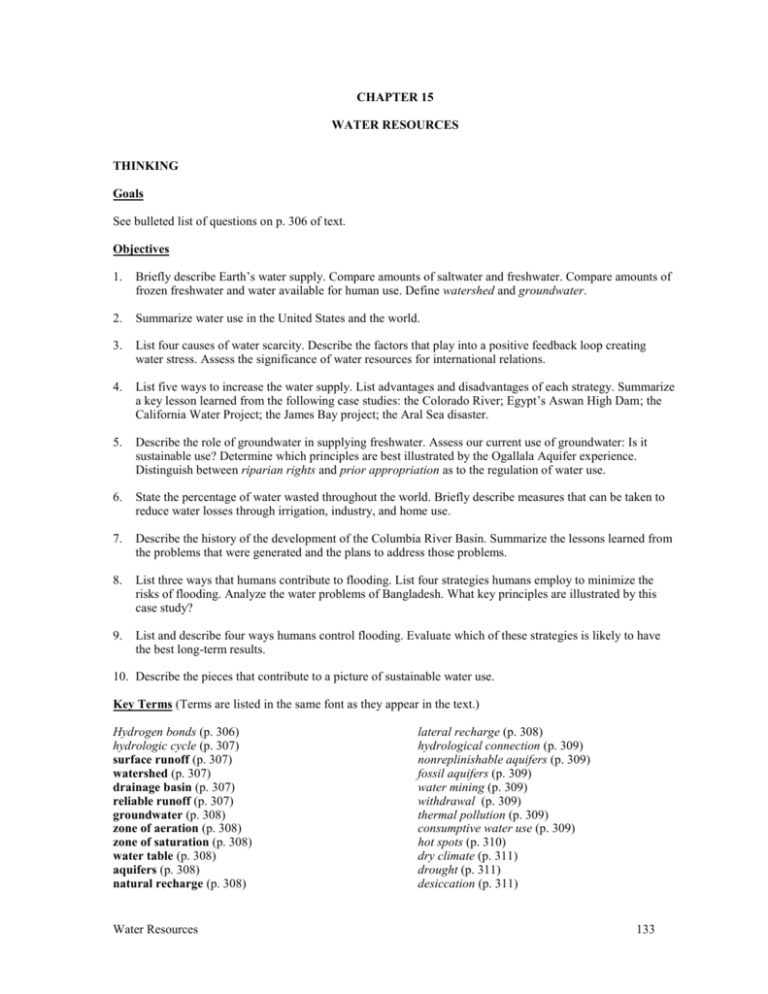
CHAPTER 15 WATER RESOURCES THINKING Goals See bulleted list of questions on p. 306 of text. Objectives 1. Briefly describe Earth’s water supply. Compare amounts of saltwater and freshwater. Compare amounts of frozen freshwater and water available for human use. Define watershed and groundwater. 2. Summarize water use in the United States and the world. 3. List four causes of water scarcity. Describe the factors that play into a positive feedback loop creating water stress. Assess the significance of water resources for international relations. 4. List five ways to increase the water supply. List advantages and disadvantages of each strategy. Summarize a key lesson learned from the following case studies: the Colorado River; Egypt’s Aswan High Dam; the California Water Project; the James Bay project; the Aral Sea disaster. 5. Describe the role of groundwater in supplying freshwater. Assess our current use of groundwater: Is it sustainable use? Determine which principles are best illustrated by the Ogallala Aquifer experience. Distinguish between riparian rights and prior appropriation as to the regulation of water use. 6. State the percentage of water wasted throughout the world. Briefly describe measures that can be taken to reduce water losses through irrigation, industry, and home use. 7. Describe the history of the development of the Columbia River Basin. Summarize the lessons learned from the problems that were generated and the plans to address those problems. 8. List three ways that humans contribute to flooding. List four strategies humans employ to minimize the risks of flooding. Analyze the water problems of Bangladesh. What key principles are illustrated by this case study? 9. List and describe four ways humans control flooding. Evaluate which of these strategies is likely to have the best long-term results. 10. Describe the pieces that contribute to a picture of sustainable water use. Key Terms (Terms are listed in the same font as they appear in the text.) Hydrogen bonds (p. 306) hydrologic cycle (p. 307) surface runoff (p. 307) watershed (p. 307) drainage basin (p. 307) reliable runoff (p. 307) groundwater (p. 308) zone of aeration (p. 308) zone of saturation (p. 308) water table (p. 308) aquifers (p. 308) natural recharge (p. 308) Water Resources lateral recharge (p. 308) hydrological connection (p. 309) nonreplinishable aquifers (p. 309) fossil aquifers (p. 309) water mining (p. 309) withdrawal (p. 309) thermal pollution (p. 309) consumptive water use (p. 309) hot spots (p. 310) dry climate (p. 311) drought (p. 311) desiccation (p. 311) 133 water stress (p. 311) water scarcity (p. 311) hydrological poverty (p. 312) public-private partnership (p. 312) California Water Project (p. 317) sinkholes (p. 320) distillation (p. 322) reverse osmosis (p. 322) underpricing (p. 323) flood irrigation (p. 323) center-pivot low-pressure sprinklers (p. 323) low-energy precision application (LEPA) sprinklers (p. 323) surge valves (p. 323) time-controlled valves (p. 323) soil moisture detectors (p. 323) drip irrigation systems (p. 323) microirrigation systems (p. 323) xeriscaping (p. 325) gray water (p. 326) floodplain (p. 327) channelization (p. 328) levees (p. 328) floodwalls (p. 328) dams (p. 328) blue revolution (p. 329) Outline 15-1 Water’s Importance and Unique Properties A. Water is important for several reasons. 1. It keep us alive; most organisms are more than 70% water. 2. It sculpts the earth’s surface and moderates the climate. 3. Water removes and dilutes wastes and pollutants. B. The unique properties of water are mostly due to the attractive forces between its molecules. It has the following unique combination of properties. 1. There are strong forces of attraction (hydrogen bonds) between molecules of water. 2. Water exists as a liquid over a wide temperature range because of the strong forces of attraction between mater molecules. 3. Liquid water changes temperature slowly because it can store a large amount of heat without a large change in temperature. 4. Evaporating liquid water takes large amounts of energy because of the strong forces of attraction between its molecules. 5. Liquid water can dissolve a variety of compounds. 6. Water filters out wavelengths of the sun’s ultraviolet (UV) radiation that would harm some aquatic organisms. 7. Attractive forces between water molecules cause its surface to contract and to adhere to and coat a solid. 8. Unlike most liquids, water expands when it freezes (this means that ice floats on water). C. We waste water, pollute it, and charge too little for making it available. 15-2 Supply, Renewal, and Use of Water Resources A. The management of water’s supply, renewal, and use is a huge twenty-first century challenge. Only about 0.01% of the earth’s supply of water is available as freshwater in the soil, in usable groundwater, water vapor, lakes and streams, but this supply is recycled. B. The hydrologic cycle collects, purifies, recycles, and distributes the world’s freshwater supply. C. Overloading the earth’s water systems with slowly degradable and nondegradable wastes and withdrawing underground water faster than it is replenished is compromising the hydrologic cycle. D. Some countries have more water than they need; some countries have far less. Poor people have less access and less availability to water, just as to food supplies. E. Water that flows across the earth and empties into rivers, streams, lakes, etc., and so does not infiltrate the ground or evaporate into the atmosphere, is called surface runoff. 1. A watershed/drainage basin is that region from which surface water drains into a body of water. 2. Reliable runoff is the runoff that is stable from one year to the next and can be counted on for a water supply. 3. Water that percolates down through the ground and is stored in pores, crevices, etc. is groundwater, an important freshwater source. a. The zone of aeration is close to the surface, and pores/spaces here contain a mixture of air and water. b. In the zone of saturation, the spaces in the ground are filled with water. c. The water table is located at the top of the zone of saturation. 134 Section One: Chapter 15 d. F. An aquifer is deeper down in the geologic layers and is like an elongated sponge with watertight layers of rock or clay below the aquifer to keep water from seeping out. e. A natural recharge replenishes an aquifer through the precipitation that percolates down through soil and rock. This recharge occurs extremely slowly. f. Lateral recharge is replenished from the side of nearby streams. g. Water mining withdraws water from deep underground, ancient deposits of water that are not generally recharged. The world’s demand for water now requires 54% of the world’s reliable runoff of surface water. We could be using 70–90% by 2025. In some places, usage rates are exceeding the reliable runoff available. 1. Water taken from streams to cool power plants is returned to the stream, but the higher water temperature causes thermal pollution downstream from the return and disrupts aquatic life. 2. Consumptive water is water not available for reuse due to evaporation, seepage into soil contamination, or movement to another area. 3. 70% of the water we withdraw from surface water/aquifers is used to irrigate crops, which accounts for 40% of the world’s food. About 85% of this water is consumed, not returned to its water basin. 4. Industries use 20% of such water. 5. And cities and residencies use 10% of reliable runoff. 6. The daily minimum amount of water needed to support three-fourths of the world’s people is equal to the amount of water used to irrigate the world’s golf courses. 7. The U.S., unlike many other countries, has enough freshwater, but its availability is influenced by differences in climate. This unequal distribution of water could set off “water wars,” especially in the Western states, in the next 20 years. 15-3 Too Little Water Water resource problems rest on too little water. A. Water scarcity arises from a dry climate, drought, dry soil, and too many people straining the water supply. 1. A drought occurs when precipitation is at least 70% lower than usual and evaporation is higher than normal for more than 21 days. 2. Desiccation occurs when the soil dries out because of deforestation and overgrazing. 3. Increasing numbers of people relying on limited runoff produces a low per capita availability of water, which leads to water stress. Water stress comes when the volume of reliable runoff per capita drops to below 60,000 cubic feet/year. 4. Water scarcity occurs when per capita water availability falls below 35,000 cubic feet per year. B. Almost 41% of the world’s population lives in river basins located in 20 countries that suffer from either water stress or water scarcity. This figure could reach 40 countries by 2020 and 60 countries by 2050. 1. The volumes of water in some of the world’s largest lakes have shrunk by 85–92% since 1960 because of water diversion and periods of prolonged drought. 2 A United Nations study found that one of six people do not have access to adequate, affordable, and clean water. 3. Poor people live in hydrological poverty—they have no access and/or cannot afford clean water at a reasonable cost. 4. Freshwater supply can be increased by building dams to store water for later use, importing water from elsewhere, using groundwater, and utilizing desalination processes. 5. People in developed countries live near water supplies, but people in developing countries must make do with what is available. 6. Most people believe that everyone has a right to clean water. 7. Most water resources are owned by governments and managed as publicly owned resources, but a number of governments are hiring private companies to manage them. There have been mixed results, and the lesson learned is that governments need to maintain strict oversight of these contracts. 8. Two possible problems with a totally privatized water system are: (1) private companies have an incentive to use as much water as possible rather than conserve it and (2) the poor will continue to be left out because they can’t pay for the water. Water Resources 135 15-4 Using Dams and Reservoirs to Supply More Water A. Dams and reservoirs capture and store runoff water. There are an estimated 800,000 dams that restrict the flow of rivers worldwide. 1. The water is released to control floods, generate electricity, and irrigate lands. 2. Reservoirs also provide for swimming, fishing, and boating. 3. But dam and reservoir construction displaces people and floods productive land. 4. The ecological services that rivers provide are given no value when building dams/reservoirs. 5. A series of dams on a river in an arid area can disrupt the hydrologic cycle, since the water may not reach the sea that it previously supplied with water. 6. About 60% of the world’s major river basins are strongly or moderately fragmented and disturbed. At least 24% of the world’s freshwater fish species are threatened or endangered. 7. The Colorado River is 1,400 miles long and has been altered by 14 major dams and reservoirs to the point that water rarely reaches the Gulf of California now. This endangers many species that spawn in the river system and has led to increased salt contamination of aquifers near the coast. a. The dams and reservoirs make it possible to grow crops, have recreation, raise livestock, generate electric power, and increase the population of rather arid areas. b. The pacts that were drawn for water allocations to the U.S. and Mexico did not consider environmental needs; no allocations were made for the environment. c. Water was supplied to farmers and ranchers at a low price. This has led to inefficient use of this water, including growing high water demand crops such as cotton, rice, and alfalfa. d. Other problems include evaporation, leakage, and siltation from large reservoirs. 8. The Three Gorges Dam on the Yangtze River (in China) will be the largest hydroelectric dam and reservoir in the world. a. 1.3 million people are being relocated on some land that will not grow much food. b. The dam will reduce China’s dependence on coal and hold back the Yangtze’s floodwaters. c. Large cargo-carrying ships will be able to go into China’s interior and thus reduce current transportation costs. d. The dam is built over a seismic fault, and there is worry that millions of people will be killed should the dam collapse. 15-5 Transferring Water from One Place to Another A. Water transfer has proven controversial; an example of this is the Aral Sea disaster. Enormous amounts of water have been diverted from the inland sea to irrigate very dry land to raise cotton and rice. 1. Large-scale water diversion projects, droughts, and high evaporation rates has caused regional ecological, economic, and health disasters. 2. This activity has tripled the salinity of the sea since 1960. The surface area has decreased by 58%, and 83% of its water has been lost. 3. About 85% of the area’s wetlands have been eliminated; roughly half the birds and mammal species have disappeared. 4. Huge areas of the lake bottom are now white salt desert that appears to have caused the extinction of 20 of the 24 native fish species. 5. The fishing industry has disappeared; salty dust from the exposed seabed blows onto fields as much as 190 miles away. Chemicals used to raise crop yields are poisoning the groundwater. 6. The reduction in the size of the sea has changed the area’s climate for the worse. 7. Health problems from the toxic dust, salt, and contaminated water plague the people. 8. Crop yields have decreased by 20–50% on almost a third of the area’s cropland. 9. Since 1999, the UN and the World Bank have spent about $600 million to purify drinking water, upgrade irrigation efficiency, and flush salts from croplands. 10. Some artificial wetlands and lakes have been constructed to help restore aquatic vegetation, wildlife, and fisheries. With the various improvements, the water volume in the Aral Sea has stabilized. B. California has been transferring water from northern California to the dry southern California area. 1. Southern California is heavily populated while being used for agriculture. 2. Water is used inefficiently and for water thirsty crops in southern California. 3. Opponents to sending more water south state that this would degrade the Sacramento River, disrupt the fisheries, and reduce the flushing action that helps to clean San Francisco Bay of pollutants. 136 Section One: Chapter 15 C. Mono Lake (a salt lake) has had its volume reduced by one-third by diversion of water from feeder rivers, and this has reduced the populations of resident and migrating gulls, ducks, and wading birds and led to lawsuits to greatly reduce diversion of water flowing into the lake. D. It is predicted that sometime this century many city dwellers and farmers will have to leave southern California due to lack of water. E. The answer does not lie with pumping out more groundwater, but with growing less water thirsty plants, improving the efficiency of irrigation, and allowing farmers to sell cities the legal rights to withdraw certain amounts of water from rivers. F. Canada has a large-scale project to harness water flowing into James Bay and Hudson Bay to produce electric power for both Canadian and U.S. use. 1. The watershed area affected by this transfer project is three times the size of New York State. 2. Boreal forest and tundra that equals the size of Washington State or Germany will be flooded. 3. It will also displace many indigenous Cree and Inuits. 4. The second phase has been postponed indefinitely because the first phase generated more power than could be sold. 5. The electricity generated is equal to that from 26 large coal-burning or nuclear power plants. 15-6 Tapping Groundwater, Converting Saltwater to Freshwater, Seeding Clouds, and Towing Icebergs and Big Baggies Most aquifers are renewable sources unless the water is removed faster than it is replenished or becomes contaminated. A. Aquifers provide drinking water for about 25% of the world’s people. B. The advantages of withdrawing groundwater are that it is a fairly cheap process if the withdrawal rate does not exceed the recharge rate and if the aquifer does not become contaminated. C. Disadvantages of withdrawing groundwater include falling water tables, land sinking below the aquifers, and saltwater intrusion into the aquifers in coastal areas. 1. Groundwater is being withdrawn at four times its replacement rate in the U.S. The huge Ogallala Aquifer lays under eight states in the arid high plains and has serious water overdraft problems. 2. Saudi Arabia gets 70% of its drinking water from the world’s largest desalination complex on its coast. Deep aquifers supply the rest, and these are mostly nonrenewable fossil aquifers. Most irrigated agriculture may disappear within 10–20 years. 3. This overuse of aquifers will also increase the gap between the rich and poor in some areas. 4. Withdrawing water from deep aquifers sometimes allows sand and rock to collapse and the land above the aquifer to subside. Recharge of these compressed aquifers is no longer possible. 5. Another problem comes from the collapse of the roof of a cavern, causing the formation of sinkholes. 6. Contamination of aquifers by intrusion of saltwater occurs along some coastal areas in the U.S. D. Scientists are evaluating deep aquifers as future water sources. 1. Core-drilling techniques are used to locate these large fossil aquifers. 2. There are two major concerns about tapping this source. a. The geological and ecological impacts of pumping water from these aquifers are unknown. b. There are no treaties/agreements that indicate who has rights or ownership of water under several different countries. E. A different method of producing freshwater is to desalinate it. Desalination removes salt from ocean or brackish groundwaters. 1. One desalination method is distillation, which heats saltwater until it evaporates and condenses as freshwater; the salts are left behind as solids. a. Desalination is very expensive because of the amount of energy used. b. Desalination produces large amounts of wastewater, which must be disposed of. 2. Another method of desalination is to use reverse osmosis, a method of pumping salt water under high pressure through a thin membrane. 3. The Middle Eastern countries produce about 60% of the desalinated water in the world. 4. Desalination is currently only feasible for rich, coastal areas due to its high cost. F. Cloud seeding has been tried by 25 countries. Dry ice or some other particles are seeded into clouds to act as a nucleus for raindrops. 1. This does not work well in very dry areas because there are few clouds in these regions. 2. This method introduces large amounts of the chemicals used into soil and water systems and may harm people and wildlife. Water Resources 137 3. 4. Seeding has led to legal disputes over the ownership of cloud water. Some analysts proposed towing icebergs or huge bags of water to arid coastal areas from the Arctic of Antarctica, but there is no technology to do this and the expense would be too great. 15-7 Reducing Water Waste A. 65–70% of water that we now use is wasted through evaporation, leaks, and other losses. B. Being more careful of water use will provide water for the foreseeable future. C. Reasons for water being wasted are that it is underpriced, and we do not reward conservation. 1. Government subsidies should be for improving the efficiency of water use, not to support farmers’ energy costs for obtaining water. 2. Lifeline water pricing is a means of giving each household an amount of water for basic needs; excess usage means higher prices. D. Improved irrigation techniques could save water. 1. Use center-pivot low-pressure sprinkler irrigation, which sprays water directly on a crop, rather than flood irrigation, which provides water flowing in ditches in crop fields. 2. Low-energy precision application (LEPA) sprinklers spray water closer to the ground than the center-pivot low-pressure sprinkler, using less energy and less water. 3. Surge/time-controlled values on conventional gravity flow irrigation systems send water down irrigation ditches in pulses, rather than in a continuous stream. This can increase efficiency to 80% and reduce water use by 25%. 4. Use soil moisture detectors to water crops only when they need it. 5. Drip irrigation/microirrigation systems are the most efficient ways to move small amounts of water to crops. Small holes in a network of perforated plastic tubing deliver drops of water at a slow and steady pace to plant roots. a. It is very efficient with water input reaching crops. b. Drip systems cost one-tenth as much per hectare as conventional drip systems. 6. DRiWATER consists of one-liter packages of gel-encased water that is buried near plant roots. The water is released slowly into the soil; it is “drip irrigation in a box.” 7. Poor farmers used pedal-powered treadle pumps to move water into irrigation ditches and buckets/tanks with holes for irrigation. E. In order to waste less water in industries, homes, and businesses, we can: 1. Replace green laws and ornamental shrubbery with vegetation that needs little water; this is called xeriscaping. 2. Use drip irrigation. 3. Raise water prices. 4. Fix leaks. Mimic nature in dealing with wastes. 5. Use water-saving toilets and like appliances. Discontinue dumping industrial toxic wastes into municipal sewer systems. F. We must use water more sustainably across the globe and reduce demand for water. 1. We must discontinue wasting water. 2. Raising water prices would cause less use. a. High quality is used to flush toxic industrial wastes into sewers and send them to treatment plants where they are not always removed. b. Five principles can be used to redesign the way we manage sewage and industrial wastes while saving great quantities of water. 1) Use pollution prevention and waste reduction to decrease industrial wastes produced. 2) Ban discharge of industrial toxic wastes into municipal sewer systems 3) Rely more on waterless composting toilets rather than conventional ones. 4) Return nutrient rich sludge produced at waste treatment plants to the soil as fertilizer. 5) Shift to new ways to treat sewage that mimic the way nature breaks down and recycles nutrients in organic waste material. 15-8 Too Much Water A. Flooding occurs when heavy rain and snowmelt cause streams to overflow onto adjacent land, a floodplain. B. People settle on floodplains because of fertile soil; ample water; nearby rivers for transportation and recreation; and flat land for crops, buildings, highways, and railroads. 138 Section One: Chapter 15 1. Natural benefits include a regular supplement of nutrient-rich silt after a flood and a recharge of the groundwater and wetlands areas. 2. Floods also kill thousands of people and cause great losses by property damage. 3. Floods are usually considered natural disasters, but since the 1960s, several types of human activities have contributed to a sharp rise in deaths and damages. 4. Removal of water-absorbing vegetation contributes to greater flooding. 5. Draining wetlands removes a needed “sponge” to absorb floodwaters and reduce the severity of floods. 6. Paving and building on floodplains also increases the chance of more severe floods. C. Clearing of forests in the Himalayas and clearing mangrove swamps on the coasts has increased flooding in Bangladesh. 1. Great floods used to occur about every 50 years or so, but since the 1970s, they now occur about every 4 years. 2. Cutting of forests in the Himalayan foothills increased runoff and carried away vital topsoil. 3. Floods and cyclones have destroyed many crops and have killed thousands of people and left many others homeless. 4. Poor families have cleared many mangrove swamps for fuelwood, farming, and aquaculture ponds for raising shrimp, which ultimately led to greater flooding with the loss of those wetlands. D. Reduce flood risk by controlling river water flows, preserving and restoring wetlands, and identifying and managing flood-prone areas. 1. Channelization reduces upstream flooding, but increases stream velocity and removes bank vegetation. 2. Levees or floodwalls can be built along the sides of streams. This method contains/accelerates the stream flow that increases the possibility for damage downstream. 3. Building dams can also reduce the threat of flooding by storing water in a reservoir for later slow release. 4. Preserve existing wetlands and restore degraded wetlands to take advantage of natural flood control. 5. Identify and manage flood-prone areas. 6. Think carefully about where we choose to live. 15-9 A More Sustainable Water Future A. A blue revolution to conserve water would include several components. 1. Use technology to irrigate more efficiently and to save water. 2. Apply economic and political realities; remove subsidies that under-price water while guaranteeing low prices for low-income consumers. Subsidize reducing water waste with rewards. 3. Develop new waste production and treatment systems that accept only non-toxic materials; use less/no water to treat wastes; return nutrients in waste to the soil; and mimic nature’s decomposition and recycling processes. 4. Leave enough water in rivers to protect wildlife, ecological processes, and the natural ecological services provided by rivers. B. Ecological restoration efforts show that wildlife and good ecological health will return. 1. We can use and waste less water. 2. Support government policies that result in more sustainable use of water and better ways to treat industrial and household wastes. 3. Reducing meat consumption will also lower water use and water pollution. Summary 1. Water’s unique properties include the hydrogen bonds, high specific heat, evaporative cooling, being the universal solvent, ionization into hydrogen ions and hydroxyl ions, high surface tension, adhesion, cohesion, and highest density at 4C. 2. Approximately 0.01% of the earth’s water supply is available as freshwater. Management of the world’s water supply is a huge 21st century challenge. Water Resources 139 3. Freshwater shortages are caused by dry climate, droughts, desiccation, and water stress. Solutions for this problem include building dams and reservoirs, transport of freshwater between locations, withdrawing of groundwater, and desalination. 4. Advantages of dams and reservoirs include cheap electricity, reduction of downstream flooding, and yearround water for irrigation. Disadvantages include displacement of people and disruption of aquatic systems, and the hydrological cycle. 5. Transferring large amounts of water from one area to another can give stream runoff from water-rich areas to water-poor areas and aid in irrigation of farmland. It can also cause ecological, economical, and health disasters. 6. The advantages of withdrawing groundwater include water for drinking and irrigation, availability and locality, low cost, no evaporation losses, and being renewable. Disadvantages include aquifer depletion from overpumping, subsidence, pollution, saltwater intrusion, and reduced water flow. Desalination increases the supply of freshwater but is expensive and produces large quantities of wastewater. 7. We can waste less water by lining canals, leveling fields, irrigating at night or using new irrigation techniques, polyculture or organic farming, seasonal farming, irrigating with treated wastewater, and importing water-intensive crops and meat. 8. Flooding is caused by heavy rain or melting of snow within a short time. To reduce flood damage or the risk of flooding we must avoid building on floodplains, removing water-absorbing vegetation, or draining wetlands. 9. Methods for achieving more sustainable use of the earth’s water include not depleting aquifers, preserving aquatic systems and water quality, using integrated watershed management, creating agreements among regions and countries sharing surface water resources, outside party mediation of water disputes between nations, marketing of water rights, raising water prices, wasting less water, decreasing government subsidies for reducing water waste, and slowing population growth. Test Items See Instructor’s Manual, Section Two, p. 487. More Depth: Conceptual Term Paper Topics 1. Flooding: history of flooding in the United States or Asia: change in rates and possible causes. 2. Droughts: drought history of the African Sahel. 3. Water supply through dams and water transfer projects: trickle irrigation; water diversion projects in China and India; new dams in South America and their effects on indigenous people; the James Bay project; the California Water Project; the Columbia River. 4. Water supply through groundwater: urban construction and aquifer recharge problems; the Ogallala Aquifer. More Breadth: Interdisciplinary Activities and Projects 1. Ask your class to determine the local agricultural and industrial uses of water. Is irrigation used widely? What is the source of irrigation water? What water conservation practices are used by local government, industry, and agriculture? 2. Ask your students to bring to class and share paintings, photographs, poems, songs, or other expressions of intense human feelings about water as a life-sustaining and precious substance. 140 Section One: Chapter 15 3. Invite a local, state, or federal water-supply official to discuss the water-supply problems of your area with your class. Investigate the water-supply needs of your area and the strategies that are being used to meet those needs. 4. Visit a dam. Investigate environmental impacts of the dam. Draw a model of all of the factors that create positive and negative loops as a result of the dam. Multisensory Learning: Audiovisuals Bangladesh: Living with Flooding; 1995; 20 min.; FHS. Boiling Point, the global struggle for water. 2004. 27 min. FHS. Drinking Water: Quality on Tap; 1991; 25 min.; how the source of water, the supply, the treatment, and the delivery systems work together to provide quality drinking water; VP. Estuary; 12 min.; closeup of wetlands and waterways; BFF. How People Are Helping Coasts, item #58838, 1990; 60 min.; NWF. Large Dams, False Promises; 1994; 36 min.; major destruction to ecosystems caused by construction of large dams; VP. Nigeria: Dammed Water; 1994; 20 min.; big projects, little projects; FHS. No Dam Good; BFF. Not a Drop to Drink; 1987; 16 min.; five-part series produced by CNN Science and Technology unit; CNN. Ocean Resources; 1994; 23 min.; oyster farming, chemicals in seaweed, sea organisms as natural resources; FHS. Run, River, Run; 28 min.; channel creation and rebuilding the wilderness of the Kissimmee River; SFWMD. The Mississippi Flood; 1994; 50 min.; engineering and natural flooding: Mississippi and Bangladesh; FHS. The Wasting of a Wetland; 23 min.; industry, agriculture, population growth, and the Everglades; BFF. Water: A Precious Resource; 1980; 23 min.; water cycle; water use and abuse; NG. Water: More Precious than Oil; 58 min.; PBS. Water; 1994; 23 min.; properties of water, rainwater, and mineral water; FHS. See Appendix A for suppliers. ATTITUDES/VALUES Assessment 1. Do you consume too much water? Does your community consume too much water? 2. Do you feel your community supplies enough water? Should other strategies be tried? 3. Are you confident that your community has an adequate water supply for the needs of the community for the next decade? Do you feel other strategies should be tried? 4. What are your feelings toward increasing water supply through building dams? 5. What are your feelings toward increasing groundwater withdrawal? 6. Should we meter water use and charge the full cost of providing fresh water? 7. Do you favor increasing the price of irrigation water to reflect its true cost and encourage conservation among farmers? 8. Do you favor local ordinances that conserve water? More Depth: Discussion and Term Paper Topics 1. Who owns the water in the clouds? Water Resources 141 2. What role has water supply played in wars between countries in the last decade? 3. Who has the strongest claim on California’s water supply: the farmers or the cities? 4. Is the public ready for water recycling? (Also, see text, Critical Thinking, pp. 330 and Critical Thinking and the Environment.) PARTICIPATION Lifestyle and Campus Community See Green Lives/Green Campuses, Chapter 1: Water Supply. More Depth: Action-oriented Term Paper Topics 1. Individual. Acting to conserve water: new uses for residential “gray” water; water-saving showers, faucets, and toilets. 2. Regional. The California Water Plan; James Bay; Egypt’s Aswan High Dam; China’s Three Gorges Project. 3. National. The Safe Drinking Water Act of 1974; groundwater protection; water-rights battles in the West. 4. Global. Water-supply conflicts: Jordan and Israel; Turkey and Iraq; Ethiopia and Egypt. SKILLS Environmental Problem-solving Skills: Projects 1. Have your students explore community water resources. Where does your town get its water? What is the average daily use in summer? In winter? What are the major uses in your area? (List the ten biggest users.) How much does your class use? 2. Have students pick out finished products in your classroom or home and, beginning with the raw materials, trace the use of water in giving you the final product. 3. If a dam has been constructed or is being built in your area, visit the site with your class. Ask students to find pictures of the area and its water control problems before the dam was built, evaluate whether the dam should have been built, and substantiate their claims. Were there alternatives to dam construction? What is the expected lifetime of the dam? Laboratory Skills (none) Computer Skills Water Supply Simulation Model (WSSM) -Evaluates the physical and economic characteristics of a water-supply system. -U.S. Environmental Protection Agency, Office of Research and Development, Water Engineering Research Laboratory, ATTN: Dr. James A. Goodrich, Environmental Scientist, Systems and Cost Evaluation Staff, Drinking Water Research Division, Cincinnati, OH 45268 Also, see Introduction to the Internet. 142 Section One: Chapter 15


